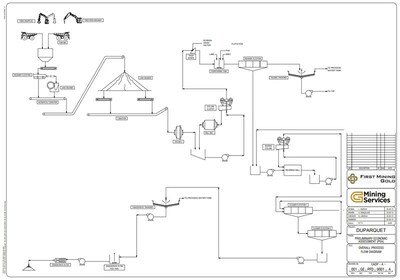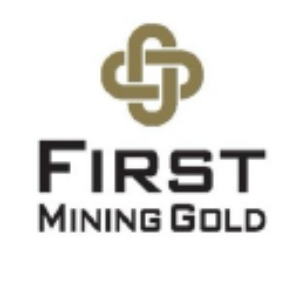First Mining Announces Positive Preliminary Economic Assessment for the Duparquet Gold Project, Quebec, Canada
Pre-Tax NPV
Pre-Tax IRR of
Average LOM Annual Gold Production of 233 koz with AISC of
C pre-tax NPV$1.07 billion 5% andC after-tax NPV$588 million 5% atUS /oz gold ("Au")$1,800 24.9% pre-tax IRR;18.0% after-tax IRR atUS /oz Au$1,800 - Annual Life-of-Mine ("LOM") recovered gold production of 233 koz
- Total LOM recovered gold of 2.5 Moz over an 11-year mine life
- Pre-tax payback of 3.8 years; after-tax payback of 4.8 years
- Initial capital costs estimated at
C ; sustaining and underground development capital costs estimated at$706 million C $738 million - Average annual LOM Total Cash Cost of
US /oz(1); average annual LOM All-In Sustaining Costs ("AISC") of$751 US /oz(2)$976
Note: Base case parameters assume a gold price of | |
(1) | Total Cash Costs consist of mining costs, processing costs, mine-level G&A, treatment and refining charges and royalties. |
(2) | AISC includes total cash costs plus sustaining capital, development capital and closure costs. |
"This PEA demonstrates the robust economic potential of the Duparquet Gold Project," stated Dan Wilton, CEO of First Mining. "The +200 koz per year production profile, attractive capital and operating cost profile and strategic location of the deposit in the heart of the Abitibi gold belt all contribute to the recognition of
This PEA for the Duparquet Gold Project was prepared by G Mining Services Inc. of
The Duparquet Gold Project, located in the Abitibi region of
The PEA evaluates recovery of gold from a 15,000 tonne-per-day ("tpd") open pit and underground mining operation, with a process plant that includes crushing, grinding, and flotation, producing a concentrate for sale.
Table 1: Key PEA Assumptions and Project Economics (1)
Key Assumptions | Unit | LOM | |
Gold Price | US$/oz | ||
Exchange Rate | C$:US$ | 1.33 | |
Production Profile | Unit | LOM | |
Total Open Pit Tonnage | Mt | 282.0 | |
Total Open Pit Mineralized Material Mined | Mt | 43.6 | |
Open Pit Strip Ratio | w:o | 5.4 | |
Total UG Mineralized Material Mined | Mt | 12.0 | |
Total Tailings Mineralized Material Mined | Mt | 4.1 | |
Total Tonnes Processed | Mt | 59.7 | |
Daily Throughput | tpd | 15,000 | |
Mill Grade | g/t Au | 1.51 | |
Mine Life | Years | 11 years | |
Gold Recovery to Concentrate | % | 89.5 % | |
LOM Metal Recovered | koz Au | 2,595 koz Au | |
Average Annual Recovered | koz Au | 233 koz Au | |
Operating Costs (US$/oz) | Unit | LOM | |
Total Cash Costs (2) | US$/oz | ||
AISC (3) | US$/oz | ||
Capital Expenditures | Unit | LOM | |
Initial Capital | C$M | ||
Sustaining and Development Capital | C$M | ||
Closure Costs | C$M | ||
Estimated Salvage Value | C$M | ( | |
Economics | Unit | LOM | |
NPV at | C$M | ||
IRR (pre-tax; post-tax) | % | ||
Payback (pre-tax; post-tax) | Years | 3.8 years; 4.8 years | |
(1) | The reader is advised that the PEA is preliminary in nature and is intended to provide only an initial, high-level review of the Project potential and design options. The PEA mine plan and economic model include numerous assumptions and the use of Inferred mineral resources. Inferred mineral resources are considered too speculative geologically to have the economic considerations applied to them that would enable them to be categorized as mineral reserves and to be used in an economic analysis except as allowed for in PEA studies. There is no guarantee that Inferred resources can be converted to Indicated or Measured resources, and as such, there is no certainty that the PEA or Project economics described herein will be realized or achieved. |
(2) | Total Cash costs consist of mining costs, processing costs, mine-level G&A, treatment and refining charges and royalties. |
(3) | AISC includes total cash costs plus sustaining capital, development capital and closure costs. |
The Project economics and cash flows are highly sensitive to changes in the price of gold.
Table 2: PEA Sensitivity to Gold Price, Operating Costs and Capital Costs
Sensitivity to Gold Price
Gold Price (US$/oz) | |||||
Pre-Tax NPV | |||||
Pre-Tax IRR | 8.5 % | 17.1 % | 24.9 % | 32.0 % | 38.6 % |
After-Tax NPV | |||||
After-Tax IRR | 5.5 % | 12.1 % | 18.0 % | 23.2 % | 28.0 % |
Sensitivity to Initial Capital Costs
Initial Capital Costs | +20 % | +10 % | -10 % | -20 % | |
Pre-Tax NPV | |||||
Pre-Tax IRR | 16.7 % | 20.4 % | 24.9 % | 30.5 % | 37.8 % |
After-Tax NPV | |||||
After-Tax IRR | 12.0 % | 14.7 % | 18.0 % | 21.9 % | 26.9 % |
Sensitivity to Operating Costs
Operating Costs | +20 % | +10 % | -10 % | -20 % | |
Pre-Tax NPV | |||||
Pre-Tax IRR | 19.5 % | 22.2 % | 24.9 % | 27.4 % | 29.9 % |
After-Tax NPV | |||||
After-Tax IRR | 14.0 % | 16.0 % | 18.0 % | 19.9 % | 21.7 % |
In September 2022, the Duparquet Gold Project Mineral Resource Estimate ("MRE") was updated by InnovExplo Inc. in accordance with NI 43-101. (See news release of September 12, 2022 for more details) The Duparquet Gold Project contains 3.44 million ounces of gold in the Measured & Indicated category, grading 1.55 g/t Au, and an additional 1.6 million ounces of gold in the Inferred category, grading 1.36 g/t Au (see Table 3).
In August 2023, new updated Mineral Resource Estimates were completed on First Mining's
Following the updated Mineral Resource Estimate at Pitt Gold and Duquesne, the consolidated Duparquet Project now contains 3.44 million ounces of gold in the Measured & Indicated category, grading 1.55 g/t Au, and an additional 2.68 million ounces of gold in the Inferred category, grading 1.68 g/t Au.
Table 3: Duparquet Deposit Mineral Resource Estimate (Effective September 12, 2022)
Area (mining | Cut-off (g/t) | Measured resource | Indicated resource | Inferred resource | |||||||
Tonnage | Au (g/t) | Ounces | Tonnage (t) | Au (g/t) | Ounces | Tonnage (t) | Au (g/t) | Ounces | |||
Potential Open Pit | 0.40 | 163,700 | 1.37 | 7,200 | 59,410,600 | 1.52 | 2,909,600 | 28,333,000 | 1.07 | 970,400 | |
Potential UG Mining | 1.50 | - | - | - | 5,506,900 | 2.26 | 399,300 | 9,038,900 | 2.29 | 665,600 | |
Tailings | 0.40 | 19,900 | 2.03 | 1,300 | 4,105,200 | 0.93 | 123,200 | - | - | - | |
Total | 183,600 | 1.43 | 8,500 | 69,022,700 | 1.55 | 3,432,100 | 37,371,900 | 1.36 | 1,636,000 | ||
Table 4: Pitt Gold and Duquesne Deposits Mineral Resource Estimate (Effective August 31, 2023) (not included in the PEA)
Area (mining method) | Cut-off (g/t) | Pitt Gold Inferred Resource | Duquesne Inferred resource | |||||
Tonnage (t) | Au (g/t) | Ounces | Tonnage (t) | Au (g/t) | Ounces | |||
Potential Open Pit | 0.50 | - | - | - | 6,300,000 | 1.56 | 316,000 | |
Potential UG Mining | 1.75 | 2,691,000 | 2.67 | 231,200 | 5,030,000 | 3.10 | 501,400 | |
Total | 2,691,000 | 2.67 | 231,200 | 11,330,000 | 2.24 | 817,400 | ||
Table 5: Duparquet Gold Project Consolidated Mineral Resource Estimate (Effective August 31, 2023)*
Area | Total Measured Resource | Total Indicated Resource | Total Inferred Resource | ||||||
(mining method) | Tonnage (t) | Au | Ounces | Tonnage (t) | Au | Ounces | Tonnage (t) | Au | Ounces |
(g/t) | (g/t) | (g/t) | |||||||
Potential Open Pit | 163,700 | 1.37 | 7,200 | 59,410,600 | 1.52 | 2,909,600 | 34,633,000 | 1.16 | 1,286,400 |
Potential UG Mining | - | - | - | 5,506,900 | 2.26 | 399,300 | 16,759,900 | 2.59 | 1,398,200 |
Tailings | 19,900 | 2.03 | 1,300 | 4,105,200 | 0.93 | 123,200 | - | - | - |
Total | 183,600 | 1.43 | 8,500 | 69,022,700 | 1.55 | 3,432,100 | 51,392,900 | 1.62 | 2,684,600 |
*Refer to respective deposit resource estimate table for cut-off grade |
Notes to accompany the Duparquet Gold Project Mineral Resource Estimates:
1. | The independent qualified persons for the |
2. | The independent qualified persons for the Pitt Gold and Duquesne mineral resource estimates, as defined by NI 43 101, are Olivier Vadnais-Leblanc, P.Geo., Carl Pelletier, P.Geo., and Simon Boudreau, P.Eng. from InnovExplo. The effective date of the estimate is August 31, 2023. |
3. | These mineral resources are not mineral reserves, as they do not have demonstrated economic viability. There is currently insufficient data to define these Inferred mineral resources as Indicated or Measured mineral resources and it is uncertain if further exploration will result in upgrading them to an Indicated or Measured mineral resource category. The mineral resource estimate follows current CIM Definition Standards. |
4. | The results are presented in situ and undiluted and have reasonable prospects of eventual economical extraction. |
5. | In-pit and Underground estimates encompass sixty (60) mineralized domains and one dilution envelop using the grade of the adjacent material when assayed or a value of zero when not assayed; The tailings estimate encompass four (4) zones. |
6. | |
7. | Pitt Gold: Underground: High-grade capping of 20 g/t Au. High-grade capping supported by statistical analysis was done on composited assays. |
8. | Duquesne: In-pit and Underground: High-grade capping of 55 g/t Au. High-grade capping supported by statistical analysis was done on composited assays. |
9. | In-pit and Underground: For |
10. | In-pit and Underground: For |
11. | In-pit and Underground: For |
12. | The Mineral Resource Estimate for Duquesne and Pitt Gold was prepared using 3D block modelling and the inverse distance squared ("ID2") interpolation method. |
13. | The mineral resources are categorized as Inferred based on drill spacing, as well as geological and grade continuity. A maximum distance to the closest composite of 75 m for Inferred in all zones for Duquesne of 210 m for Inferred in all zones for Pitt Gold. |
14. | The reasonable prospect for an eventual economical extraction is met by having used reasonable cut-off grades both for a potential open pit and underground extraction scenarios (minimum mining width of 2m) and constraining volumes (Deswik optimized shapes and Whittle optimized pit-shells). |
15. | In-pit and Underground: The mineral resource estimate is locally pit-constrained with a bedrock slope angle of 50° and an overburden slope angle of 30°. The out-pit mineral resource met the reasonable prospect for eventual economic extraction by having constraining volumes applied to any blocks (potential underground extraction scenario) using DSO. |
16. | The number of metric tons was rounded to the nearest thousand and ounces were rounded to the nearest hundred, following the recommendations in NI 43 101. Any discrepancies in the totals are due to rounding effects. |
17. | The qualified persons are not aware of any known environmental, permitting, legal, title-related, taxation, socio-political, or marketing issues, or any other relevant issue not reported herein, that could materially affect the Mineral Resource Estimate. |
The database used for the Duparquet MRE contains 904 holes totalling 270,119m and 173,831 sampled intervals. The resource area has an E-W strike length of 4.5 km, a width of approximately 1 km, and a vertical extent of 1,050 m below surface. A total of 60 mineralized zones wireframes have been created for the
The database used for the Duquesne MRE contains 1,011 underground drill holes for a total of 51,957.43m and 393 surface Diamond Drill Holes ("DDH") totaling 103,888.19m. The DDH intervals used for the interpretation contain 66,411 assays taken from the 1404 drill holes and surface channels (71,034.71m of core). A total of 389 mineralized zones wireframes have been created for the Duquesne deposit. Mineralized zones average thickness in the deposit varies between 0.69 m and 4.28 m with an interpreted average thickness of 1.89 m.
The database used for the Pitt Gold MRE contains 163 surface diamond drill holes totaling 70,364.67m. A total of 119 mineralized zones wireframes have been created for the Pitt Gold deposit. Mineralized zones average thickness in the deposit varies between 0.71 m and 3.03 m with an interpreted average thickness of 1.56 m.
The capital cost estimate for the proposed open pit operation in the PEA is based on the scheduled plant throughput rates, as well as a review of similar sized open pit gold operations.
Table 6: Capital Cost Details
Total Capital Cost | C$M |
Infrastructure | |
Power & Electrical | |
Water | |
Surface Operations | |
Mining | |
Process Plant | |
Indirect | |
Owner's Cost | |
Construction cost | |
Contingency | |
Pre-Production | |
Working Capital | |
Initial Capital | |
Sustaining and Development Capital | |
Closure Costs | |
Salvage Value | ( |
Total Capital |
The open pit mining activities for the Project were assumed to be undertaken by an equipment financed fleet. Mining capital costs were estimated based on a detailed equipment schedule matched to the mining production schedule. Total initial mining capital was estimated at
The process plant was designed using conventional processing unit operations. It will nominally treat 15,000 tpd or 679 dry tonne/hour based on
Initial capital costs for the processing facility were estimated to be
Operating Costs
Table 7: Operating Cost Details
Operating Costs per Tonne | Unit | LOM |
Mining Costs – OP (inc. historic tailings) | C$/t mined | |
Mining Costs – OP (inc. historic tailings) | C$/t processed | |
Mining Costs – UG | C$/t processed | |
Processing Costs | C$/t processed | |
G&A Costs | C$/t processed | |
Total Operating Costs | C$/t processed | |
Other Costs | LOM | |
Transport Costs | C$/t | |
Treatment Charges | C$/dmt | |
Refining Charges | US$/oz |
The PEA contemplates open pit and underground mining undertaken by an equipment financed fleet. An average unit mining cost of
Underground mining cost was also estimated using first principles with supplier's quotations for equipment, consumables, contractor work, and is based on experience with underground operations with similar size and environment. The underground mining costs of
An average cost of
Open pit mining would occur in year one concurrent with underground development. Over the LOM, the open pit will deliver an average of 10,400 tpd of mineralized material to the mill. The annual peak of mineralized material delivered to the mill is 12,670 tpd in year 8. Underground production is expected to begin in year two with an average underground production rate of 3,500 tpd. Over an 11-year mine life, A total of 59.7 Mt of mineralized material (including pre-production) will be mined, which includes 4.1 Mt of historical tailings. The current LOM plan focuses on achieving consistent processing feed production rates, mining of higher-grade material early in the schedule, and balancing grade and strip ratios.
The Duparquet Project is planned as a mix of conventional open pit mine and a long hole (transversal – longitudinal – uppers) underground mine.
Open pit mining will be done with the use of diesel equipment including drilling rigs and haul trucks coupled with hydraulic shovels. The Project consists of seven (7) pits with Pit 1 having three (3) phases. The LOM will last for 11 years including a pre-production and construction period where waste will be mined for construction purposes (dams, roads, etc.) and mineralized material will be stockpiled ahead of the process plant commissioning.
Production drilling and mining operations will take place on a 10 m bench height. The primary production equipment includes 12m³ diesel-hydraulic shovel coupled with 65 tonnes Drammis trucks for the mineralized material and 22m³ diesel-hydraulic production shovels coupled with 200 tonnes off highway mining trucks for the waste. An owner mining operation is planned with overburden stripping, topographic drilling activities, and supply of explosives outsourced to contractors.
For the underground mine, long hole stopping, both transverse and longitudinal with cemented rockfill ("CRF") is the preferred mining method. Mineralized material will be removed from the stopes using a high production sized load-haul-dump ("LHD"). The underground mine's main declines will be accessible from surface through a single portal located north of the site.
In addition to the open pit and underground mines, a portion of the historical tailings will be transported and processed at the mill. A maximum of 750,000 t of material will be processed yearly.
The PEA reflects gold recoveries that were a result of the extensive metallurgical test work completed by Clifton Star Resources Inc. ("Clifton Star") during 2012 to 2014. The test work involved several rounds of bench scale and pilot plant testing of flotation concentration. In addition, Clifton Star completed extensive metallurgical test work on follow-on processing to treat the sulfide concentrates with fine grinding and alkaline leaching, bio-oxidation, and pressure oxidation but was not included in the PEA flowsheet.
Based on the test work carried out and trade-off studies conducted as part of the PEA, the Project was scoped with a flowsheet that includes comminution circuit and rougher and cleaner flotation to produce a high-grade gold concentrate for sale. This flowsheet is based on a primary grind size of
The preliminary process plant design for the Duparquet Project is based on a robust metallurgical flowsheet to treat gold bearing material to produce gold concentrate. The flowsheet is based on previous metallurgical test work by Clifton Star, industry standards and conventional unit operations.
The process plant is designed to nominally treat 15,000 tpd of mineralized material and reprocessing of existing tailings. The flowsheet will consist of primary crushing, SAG and ball mill grinding, rougher and cleaner gold flotation circuits, concentrate dewatering and load out facilities. Flotation tailings will be dewatered in a thickener to produce a tailings slurry for storage onsite. The process plant will include reagents, air systems and utilities to support the operation.
Figure 1 represents the overall flowsheet for the Duparquet Gold Project.
The Project is located immediately north of the town of
The infrastructure and process plant platform will be located on the north side of the pits. The waste rock stockpiles will be located on each side of the pits. A haul road is planned to connect the pits to the waste stockpiles, overburden stockpiles, process plant and Tailings Storage Facility.
The Tailings Storage Facility ("TSF") design will take advantage of the existing topographic and ground conditions in the eastern part of the Project site. The TSF will provide enough capacity for 34.5 million cubic meters of tailings. A tailings deposit basin will be created by building a main dam at the downstream end of the valley and the tailings dams will be constructed in phases to minimize the initial capital. The process plant tailings will be pumped to the TSF through a 4 km pipeline and will be thickened prior to deposition. The reclaim water system will consist of a reclaim barge equipped with two reclaim water pumps.
Approximately 22.7MW of electrical demand will be supplied via a new 120 kV overhead transmission line, built to connect to the provincial grid's 120 kV line approximately 15 km to the southeast in Reneault Hydro-Québec substation. Main distribution network is made at 13.8 kV from the main substation where two (2) fully redundant power transformers are installed. Distribution to the equipment is made at 4.16 kV and 600V.
The PEA has considered and incorporated the opportunity to leverage the Duparquet Gold Project development with the reclamation of the brownfield site conditions including the removal and reprocessing of over 4.1 Mt of uncontained historical mine tailings. With such measures incorporated into the PEA mine plan, in combination with the ability of the Project to collect and treat historically impacted groundwater via the excavation and dewatering of the open pit, the Project is positioned to deliver both environmental benefits and socio-economic benefits via employment, contracting and revenue for the Municipality of
Since acquiring the Duparquet Gold Project in September of 2022, First Mining has prioritized meeting the people, communities and government representatives on project planning in an open and transparent manner. First Mining published the Mines d'Or Duparquet website to share project information and has recently finished renovations required to open a First Mining community relations office in
The Municipality of
The PEA identified several opportunities to enhance the economics of the Duparquet Gold Project and will be investigated as First Mining continues to advance the Project. These opportunities include:
- Exploration Drilling – opportunity to expand the resource with drilling regionally along 19 km of First Mining's property over the
Destor -Porcupine fault zone; First Mining is in the process of completing an initial 5,000 metre drill program at the Project and intends to start a Phase II drill program later in 2023 - Infill Drilling – opportunity to expand the resource and increase the grade profile at the Project
- Silver Mineralization – opportunity to incorporate silver mineralization into the economics; the PEA does not contemplate any payable silver ounces
- Additional Technical Studies – opportunity to optimize project economics by reducing sustaining capital, development capital and operating costs
- Incorporating New Mineral Resource – opportunity to improve project economics by incorporating new mineral resource estimates into the mine plan from nearby Pitt and Duquesne deposits, which form part of the larger Duparquet Gold Project
- Regional Consolidation – opportunity to consolidate refractory deposits in the region to create a central processing facility to treat feed from other regional mines
- Test work on Historical Tailings – opportunity to optimize the blending of the old tailings through the process with additional test work
- Metallurgical Test work – opportunity to improve metallurgical recoveries and concentrate grade with additional metallurgical test work
- Water Management – opportunity to optimize water treatment and services estimate with additional studies
- Tailings – opportunity to optimize tailings and design and cost estimates with additional studies
- Infrastructure – opportunity to optimize town infrastructure in project design
The PEA for the Duparquet Gold Project summarized in this news release was prepared by G Mining Services Inc. and will be incorporated in a NI 43-101 technical report which will be available under the Company's SEDAR profile at www.sedarplus.ca , and on the Company's website, within 45 days of this news release. The affiliation and areas of responsibility for each of the Qualified Persons involved in preparing the PEA, upon which the technical report will be based, are as follows:
Table 7: Qualified Persons for PEA NI 43-101
Qualified Persons | Company | Area of Expertise |
Carl Michaud, P.Eng. | G Mining Services Inc. | Operating Cost Estimation, Economic Analysis |
Alexandre Dorval, P. Eng. | G Mining Services Inc. | Open pit Mine Engineering |
Marina Iund. P.Geo. | InnovExplo Inc. | Duparquet MRE |
Olivier Vadnais-Leblanc, P.Geo. | InnovExplo Inc. | Duquesne and Pitt Gold MRE |
Carl Pelletier. P.Geo. | InnovExplo Inc. | |
Simon Boudreau, P. Eng. | InnovExplo Inc. | |
Neil Lincoln, P. Eng. | G Mining Services Inc. | Mineral Processing and Recovery Methods |
Philip Rodrigue, P. Eng. | G Mining Services Inc. | Infrastructure and Capital Cost Estimation |
Sheldon Smith MES, P. Geo | Stantec Consulting Ltd. | Environmental and Permitting |
Each QP has reviewed and approved the content of this news release.
The Company cautions that the results of the PEA are preliminary in nature and include Inferred Mineral Resources that are considered too speculative geologically to have the economic considerations applied to them that would enable them to be categorized as mineral reserves. There is no certainty that the results of the PEA will be realized.
The Qualified Persons responsible for the preparation of the PEA and the technical report in respect thereof have verified the data disclosed in this news release, including sampling, analytical, and test data underlying the information contained in this news release. Geological, mine engineering and metallurgical reviews included, among other things, reviewing mapping, core logs, and re-logging existing drill holes, review of geotechnical and hydrological studies, environmental and community factors, the development of the life of mine plan, capital and operating costs, transportation, taxation and royalties, and review of existing metallurgical test work. In the opinion of the Qualified Persons, the data, assumptions, and parameters used to estimate Mineral Resources and Mineral Reserves, the metallurgical model, the economic analysis, and the PEA are sufficiently reliable for those purposes. The technical report in respect of the PEA, when filed, will contain more detailed information concerning individual responsibilities, associated quality assurance and quality control, and other data verification matters, and the key assumptions, parameters and methods used by the Company.
The Company has included certain non-IFRS financial measures in this news release, such as Initial Capital Costs, Total Cash Costs and All-In Sustaining Costs, which are not measures recognized under IFRS and do not have a standardized meaning prescribed by IFRS. As a result, these measures may not be comparable to similar measures reported by other companies. Each of these measures used are intended to provide additional information to the user and should not be considered in isolation or as a substitute for measures prepared in accordance with IFRS.
Certain Non-IFRS financial measures used in this news release and common to the gold mining industry are defined below.
Total Cash Costs and Total Cash Costs per Gold Ounce
Total Cash Costs are reflective of the cost of production. Total Cash Costs reported in the PEA include mining costs, processing, water & waste management costs, on-site general & administrative costs, treatment & refining costs, royalties and silver stream credits. Total Cash Costs per Ounce is calculated as Total Cash Costs divided by total LOM recovered gold ounces.
All-in Sustaining Costs ("AISC") and AISC per Gold Ounce
AISC is reflective of all of the expenditures that are required to produce an ounce of gold from operations. AISC reported in the PEA includes Total Cash Costs, sustaining capital and closure costs. AISC per Ounce is calculated as AISC divided by total LOM recovered gold ounces.
Mr. Louis Martin P.Geo., (OGQ 0364), a consultant of First Mining, is a "Qualified Person" for the purposes of NI 43-101, and he has reviewed and approved the scientific and technical disclosure contained in this news release.
First Mining is a gold developer advancing two of the largest gold projects in
First Mining was established in 2015 by Mr. Keith Neumeyer, founding President and CEO of First Majestic Silver Corp.
ON BEHALF OF FIRST MINING GOLD CORP.
Daniel W. Wilton
Chief Executive Officer and Director
This news release includes certain "forward-looking information" and "forward-looking statements" (collectively "forward-looking statements") within the meaning of applicable Canadian and
Forward-looking statements in this news release relate to future events or future performance and reflect current estimates, predictions, expectations or beliefs regarding future events. All forward-looking statements are based on First Mining's or its consultants' current beliefs as well as various assumptions made by them and information currently available to them. There can be no assurance that such statements will prove to be accurate, and actual results and future events could differ materially from those anticipated in such statements. Forward-looking statements reflect the beliefs, opinions and projections on the date the statements are made and are based upon a number of assumptions and estimates that, while considered reasonable by the respective parties, are inherently subject to significant business, economic, competitive, political and social uncertainties and contingencies. Such factors include, without limitation the Company's business, operations and financial condition potentially being materially adversely affected by the outbreak of epidemics, pandemics or other health crises, such as COVID-19, and by reactions by government and private actors to such outbreaks; risks to employee health and safety as a result of the outbreak of epidemics, pandemics or other health crises, such as COVID-19, that may result in a slowdown or temporary suspension of operations at some or all of the Company's mineral properties as well as its head office; fluctuations in the spot and forward price of gold, silver, base metals or certain other commodities; fluctuations in the currency markets (such as the Canadian dollar versus the
First Mining cautions that the foregoing list of factors that may affect future results is not exhaustive. When relying on our forward-looking statements to make decisions with respect to First Mining, investors and others should carefully consider the foregoing factors and other uncertainties and potential events. First Mining does not undertake to update any forward-looking statement, whether written or oral, that may be made from time to time by the Company or on our behalf, except as required by law.
Cautionary Note to United States Investors
The Company is a "foreign private issuer" as defined in Rule 3b-4 under the United States Securities Exchange Act of 1934, as amended, and is eligible to rely upon the
Technical disclosure contained in this news release has not been prepared in accordance with the requirements of
NI 43-101 is a rule developed by the Canadian Securities Administrators that establishes standards for all public disclosure an issuer makes of scientific and technical information concerning the issuer's material mineral projects.
![]() View original content to download multimedia:https://www.prnewswire.com/news-releases/first-mining-announces-positive-preliminary-economic-assessment-for-the-duparquet-gold-project-quebec-canada-301920184.html
View original content to download multimedia:https://www.prnewswire.com/news-releases/first-mining-announces-positive-preliminary-economic-assessment-for-the-duparquet-gold-project-quebec-canada-301920184.html
SOURCE First Mining Gold Corp.








